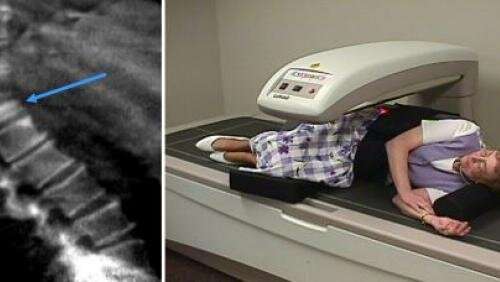New position paper urges routine use of DXA-VFA in fracture liaison services

A new position paper by an International Osteoporosis Foundation (IOF) Fracture Working Group reviews the clinical significance of vertebral fractures, and the rationale for performing vertebral fracture assessment (VFA) routinely within post-fracture care coordination programs such as fracture liaison services (FLS).
VFA is a tool available on modern dual-energy X-ray absorptiometry (DXA) scanners which allows the detection of previous vertebral fractures by providing a lateral view of the spine during a regular DXA bone mineral density measurement of the hip and spine.
Professor Willem Lems, corresponding author of the position paper, stated:
"Vertebral fractures are independent risk factors for future vertebral and non-vertebral fractures. Yet the majority occur without the signs and symptoms of an acute fracture, and they often remain undetected. Routine use of VFA technology would allow fracture liaison services to detect more undiagnosed vertebral fractures and to identify, assess and monitor more high-risk patients in need of treatment."
With the availability of powerful anabolic therapies, which appear to act more rapidly than do anti-resorptives, IOF and ESCEO have set out recommendations for stratification of treatment according to baseline FRAX probability. VFA detection of occult vertebral fractures in the FLS thus offers a valuable opportunity to further refine fracture risk assessment and to tailor treatment accordingly. Furthermore, awareness of baseline vertebral fractures facilitates definition of true new vertebral fracture events occurring during anti-osteoporosis treatment, and therefore enhances optimal monitoring and informs decisions to adjustment therapy if required.
FLS are important service models for delivering secondary fracture prevention for older adults presenting with a fragility fracture. The IOF Capture the Fracture program's Best Practice Framework, the leading global initiative in support of secondary fracture prevention delivery through FLS, defines the essential and aspirational elements of service delivery for fracture care. A questionnaire-based study of international FLSs based on the Best Practice Framework found that secondary fracture prevention is best delivered for hip fractures and remains suboptimal for vertebral fractures, where the care gap is clearly wider.
Professor Nicholas Harvey, co-author and Chair of the IOF Committee of Scientific Advisors, noted:
"This position paper, the result of the close international collaboration between colleagues in the IOF Fracture Working Group and the MRC Lifecourse Epidemiology Unit, University of Southampton, documents the substantial potential for the improved detection of vertebral fractures within fracture liaison services. The findings are perfectly synergistic with recent guidelines from IOF and ESCEO which set out a personalized medicine approach to treatment based on level of fracture risk. VFA thus offers a useful tool in the FLS with which to further characterize risk and so select the most appropriate treatment for an individual patient."
More information: Vertebral fracture: epidemiology, impact and use of DXA vertebral fracture assessment in fracture liaison services, Osteoporosis International (2021). DOI: 10.1007/s00198-020-05804-3


















